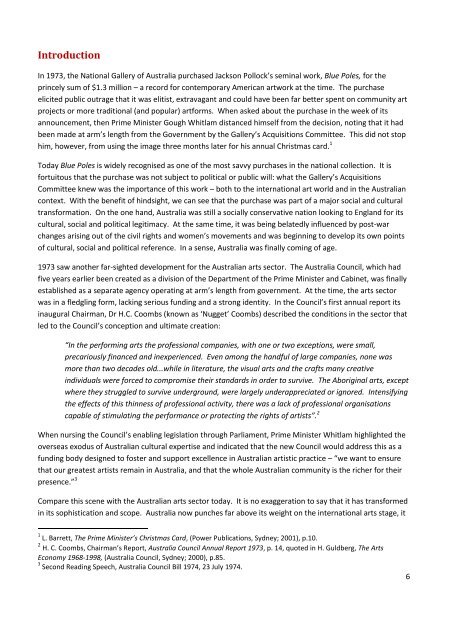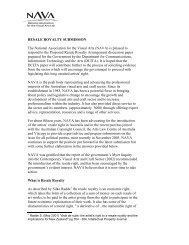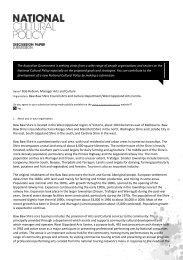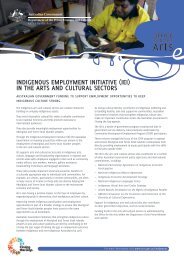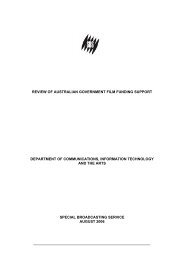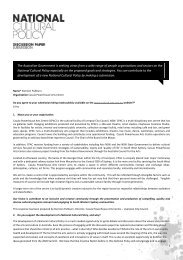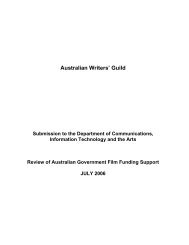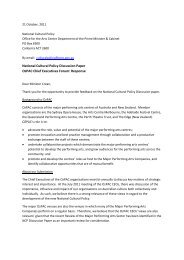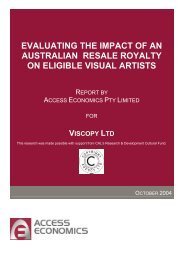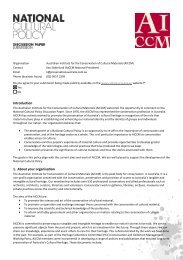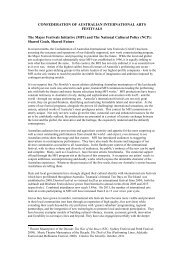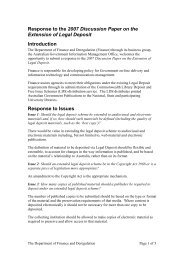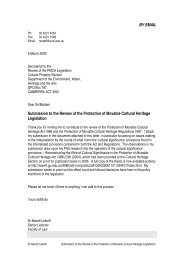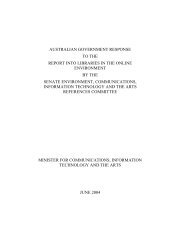IntroductionIn 1973, the National Gallery of Australia purchased Jackson Pollock’s seminal work, Blue Poles, for theprincely sum of $1.3 million – a record for contemporary American artwork at the time. The purchaseelicited public outrage that it was elitist, extravagant and could have been far better spent on community artprojects or more traditional (and popular) artforms. When asked about the purchase in the week of itsannouncement, then Prime Minister Gough Whitlam distanced himself from the decision, noting that it hadbeen made at arm’s length from the Government by the Gallery’s Acquisitions Committee. This did not stophim, however, from using the image three months later for his annual Christmas card. 1Today Blue Poles is widely recognised as one of the most savvy purchases in the national collection. It isfortuitous that the purchase was not subject to political or public will: what the Gallery’s AcquisitionsCommittee knew was the importance of this work – both to the international art world and in the Australiancontext. With the benefit of hindsight, we can see that the purchase was part of a major social and culturaltransformation. On the one hand, Australia was still a socially conservative nation looking to England for itscultural, social and political legitimacy. At the same time, it was being belatedly influenced by post-warchanges arising out of the civil rights and women’s movements and was beginning to develop its own pointsof cultural, social and political reference. In a sense, Australia was finally coming of age.1973 saw another far-sighted development for the Australian arts sector. The Australia Council, which hadfive years earlier been created as a division of the Department of the Prime Minister and Cabinet, was finallyestablished as a separate agency operating at arm’s length from government. At the time, the arts sectorwas in a fledgling form, lacking serious funding and a strong identity. In the Council’s first annual report itsinaugural Chairman, Dr H.C. Coombs (known as ‘Nugget’ Coombs) described the conditions in the sector thatled to the Council’s conception and ultimate creation:“In the performing arts the professional companies, with one or two exceptions, were small,precariously financed and inexperienced. Even among the handful of large companies, none wasmore than two decades old...while in literature, the visual arts and the crafts many creativeindividuals were forced to compromise their standards in order to survive. The Aboriginal arts, exceptwhere they struggled to survive underground, were largely underappreciated or ignored. Intensifyingthe effects of this thinness of professional activity, there was a lack of professional organisationscapable of stimulating the performance or protecting the rights of artists”. 2When nursing the Council’s enabling legislation through Parliament, Prime Minister Whitlam highlighted theoverseas exodus of Australian cultural expertise and indicated that the new Council would address this as afunding body designed to foster and support excellence in Australian artistic practice – “we want to ensurethat our greatest artists remain in Australia, and that the whole Australian community is the richer for theirpresence.” 3Compare this scene with the Australian arts sector today. It is no exaggeration to say that it has transformedin its sophistication and scope. Australia now punches far above its weight on the international arts stage, it1 L. Barrett, The Prime Minister’s Christmas Card, (Power Publications, Sydney; 2001), p.10.2 H. C. Coombs, Chairman’s Report, Australia Council Annual Report 1973, p. 14, quoted in H. Guldberg, The ArtsEconomy 1968-1998, (Australia Council, Sydney; 2000), p.85.3 Second Reading Speech, Australia Council Bill 1974, 23 July 1974.6
fosters great innovation and creativity and there are real and sustainable career paths in Australia for artistsworking at the highest level of achievement across all artforms.The Australia Council has played a significant role in this transformation. For the better part of four decades,it has been the primary national funder of artistic work of excellence and of the framework that supportsthat work. During that time, it has built its support from a narrow focus on organisations working in more‘traditional’ artforms, to a broad agenda supporting artists and organisations from the smallest artist runinitiative to major performing arts companies. In 2010-11 the Council delivered grants and project funding ofnearly $164 million in the form of almost 1,900 separate grants, enabled the creation of over 7,500 newartistic works and provided direct funding to over 900 artists and 1000 organisations. 4 It now offers fundingacross 50 separate grant categories and 40 initiatives.Funding from the Council has enabled Australia to not only establish a high level of artistic practicedomestically – it has also assisted to build Australia’s international profile. Successful artists such as TraceyMoffat, Ken Unsworth, Peter Carey, Kate Grenville, John Butler Trio, the Presets, Christine Anu,Paul Grabowsky, Peter Sculthorpe, Ben Frost, Leah Purcell and Dan Sultan (to name but a few) have allreceived support from the Council at the early stages of their careers. The Council has provided targetedsupport to companies such as Back to Back Theatre and Chunky Move which, sustained by an injection ofbase funding, have built strong profiles and strengthened their organisational capacity. The Council has alsoworked over a long period with major companies that have forged international reputations, such asBangarra Dance Theatre, the Australian Chamber Orchestra and the Australian Ballet. These are but ahandful of an extensive list – it is impossible to name them all here. The evidence base is strong: funding thearts sector via an expert funding body, in the form of the Council, has served Australia well.The Council now works in a sector that is almost unrecognisable from four decades ago. It is safe to assumethat the sector will continue to evolve at an ever-increasing rate over the next four decades. The time isright for a consideration of the Council’s place in the sector, and for a detailed and honest consideration ofwhether and how it could better fulfil that role.*****In <strong>2012</strong> we are again at the precipice of significant change in Australia - this time driven by economic andtechnological rather than social forces. We have experienced the longest continuous period of growth in theAustralian economy, fuelled by the greatest mining boom in Australia’s history – with all the ensuing benefitsincluding low unemployment and a bigger economy.While Australia experienced a mild contraction as a result of the global financial crisis and the high Australiandollar, notably in manufacturing, our economy was insulated by the buffering effect of the mining boom.Australia is particularly well-placed to address global economic uncertainty: our economic credentials areamong the strongest in the world, and the Australian economy is expected to outpace all major advancedeconomies over the next two years. 5 However, we cannot ignore the economic risks currently facing manyother developed countries. What the global financial crisis did reveal to us is the vulnerability of those areas4 Australia Council 2010-11 Annual Report.5 International Monetary Fund, World Economic Outlook, April <strong>2012</strong>, quoted by the Treasurer Wayne Swan MP, “IMFWorld Economic Outlook”, 18 April <strong>2012</strong>.7
- Page 2 and 3: Cover image: Travelling Colony by B
- Page 4 and 5: In undertaking the Review, we have
- Page 8 and 9: of our economy that are open to shi
- Page 10 and 11: and enable the Council to fulfil it
- Page 12 and 13: MethodologyOn 19 December 2011 the
- Page 14 and 15: Recommendations: PurposeRecommendat
- Page 16 and 17: ooThe Council’s role within this
- Page 18 and 19: Recommended Functional Map for the
- Page 20 and 21: major and key organisations with sm
- Page 22 and 23: Comparison of government arts expen
- Page 24 and 25: 4. Key conclusions: The Council’s
- Page 26 and 27: Recommendation 10The Review recomme
- Page 28 and 29: Core elements of a revised structur
- Page 30 and 31: oThe Review believes the balance be
- Page 32 and 33: Recommended Grants Application Proc
- Page 34 and 35: Figure 33 - Overall Administrative
- Page 36 and 37: 6. Key conclusions: The Australia C
- Page 38 and 39: Appendix 1: Biography of Mr Angus J
- Page 40 and 41: Appendix :Australia Council ReviewS
- Page 42 and 43: 5.1.1 Diversify Funding ...........
- Page 44 and 45: The analysis of survey data should
- Page 46 and 47: 2. Introduction2.1 BackgroundAs par
- Page 48 and 49: differences at the 95% confidence l
- Page 50 and 51: 3. Relationship and experience with
- Page 52 and 53: 3.2 Perceptions of the grant applic
- Page 54 and 55: 3.3 Importance of Australia Council
- Page 56 and 57:
4. Perceptions of the Australia Cou
- Page 58 and 59:
„To support, encourage and promot
- Page 60 and 61:
„To develop, advocate, resource,
- Page 62 and 63:
4.2 Original purpose of the Austral
- Page 64 and 65:
4.2.3 Agreement with statements abo
- Page 66 and 67:
Figure 12: Agreement with statement
- Page 68 and 69:
4.3.1 Funding the arts/ artistsThe
- Page 70 and 71:
Responding to a changing industry,
- Page 72 and 73:
5. Practical suggestions for change
- Page 74 and 75:
„98% of Australia Council funding
- Page 76 and 77:
5.1.3 Improve communication and con
- Page 78 and 79:
within the music scene to 'support
- Page 80 and 81:
„I think the review should look a
- Page 82 and 83:
excellence is defined primarily by
- Page 84 and 85:
model, or could offer matching ince
- Page 86 and 87:
5.3 Definitions of excellenceThere
- Page 88 and 89:
• Decided by audience, peers, com
- Page 90 and 91:
5.3.5 Conceptual definitionsThere w
- Page 92 and 93:
6. Profile of respondentsDemographi
- Page 94 and 95:
Figure 21: Location%SydneyNew South
- Page 96 and 97:
Figure 24: Role in the arts%An arti
- Page 98 and 99:
6.7 Art-formMusic was the art-form
- Page 100 and 101:
A: BackgroundTo start with, we woul
- Page 102 and 103:
Literature 4Music 5Theatre 6Visual
- Page 104 and 105:
ASK ALLC4. Listed below are several
- Page 106:
55 - 64 665 - 74 775+ 8Prefer not t


